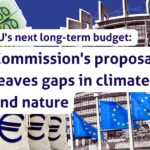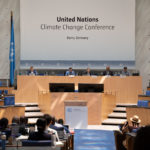-
A mural painted at Josif Pančić elementary school in Belgrade depicts the transition from dirty fossil fuels to reliable, safe and clean renewable energy sources
-
The “Energy Superheroes” Coaly, Sunny and Windy in the mural come to life thanks to augmented reality mobile phone app
-
Serbia, heavily affected by air pollution, needs to set concrete targets and action plans to move away from coal towards renewable energy sources

Belgrade, 27 October 2022 – A school playground in Serbia is launching today a mural that literally absorbs air pollution and promotes discussions among students, teachers and parents about an energy transition from dirty fossil fuels to renewable energies. The mural, painted by local artists and pupils at Josif Pančić elementary school in Belgrade, depicts this transition through the “Energy Superheroes” characters Coaly, Sunny and Windy, that come to life thanks to augmented reality mobile phone app developed for this purpose.
The painted surface covers 73 square metres of the school wall, and absorbs the same amount of smog (nitrogen oxide) as 73 trees! While painting the mural, the children and teachers talked about causes of air pollution, decarbonization and transition to renewable energy sources.
The story in the mural, inspired by the “Energy Superheroes” comic book, shows Sunny charging a phone with solar panels, Windy supplying light to a building, and Coaly turning into a diamond when he stays in the ground. In a simple and fun way, the mural conveys that the transition to renewable energies must be fair, supporting the most vulnerable people, and involving the local community, especially from towns that depend on coal mining, such as Lazarevac, Smederevo and Obrenovac in Serbia.
The driving force of the interactive mural is the NGO coalition Climate Action Network (CAN) Europe. Together with artists and partners, they proposed an engaging and simple way to introduce citizens with the opportunities that a just energy transition to renewables can offer, which is symbolised by the bridge over the river depicted on the mural. Years marked on the bridge represent the stages of the energy transition process towards a cleaner and safer future.
“Towns throughout Serbia and the region are often at the top of the list of the most polluted places in the world. Latest research shows that more than half of the citizens of Serbia live in areas where the air is excessively polluted, causing sickness and death. Nevertheless, we continue to source 80% of our electricity from coal thermal power plants, which emit polluting gases. Thus far the state has not set clear goals to map out the next steps of the energy transition towards 100% renewables. Phasing out fossil fuels and moving to solar and wind enables already today a cleaner environment and energy independence, which in the context of the current fossil fuels crisis is the key towards ensuring a safer future – both for Serbia and for Europe,” explains Masha Perovic from CAN Europe.
Serbia has committed itself to a number of international agreements and declarations to achieve climate neutrality by 2050, which also means gradually closing down outdated and polluting coal power plants. Among other issues, operation of coal thermal power plants is inefficient in several ways – energy production from coal is heavily subsidised and wasted on the maintenance of thermal power plants and mines, coupled with the costs of both state and private health insurance that pays for the treatment of pollution related illnesses.
“We believe that the state authorities are obliged to inform citizens in a timely manner and involve them in making decisions concerning their future. Throughout Europe and the world there are examples of good practice that indicate how local economies dependent on coal production have been successfully redirected to other development models, which do not harm either human health or the natural environment“, says Ognjan Pantić from the Belgrade Open School.
The ‘mural making-of’ video will be shared throughout Serbia and the Western Balkans region, in a short documentary soon be published by Marka Žvaka (Brand Bubblegum) series team, while episodes of the comic are already available on Facebook, Instagram and Twitter under #EnergySuperheroes tag.
-END-
__________________
NOTES FOR THE EDITOR
Link to all episodes of the comic in English and in Serbian
Boysen KNOxOUT pints were used to point the mural. Through the process of crystallisation of Nitrogen Oxide the air pollution is removed from the air. Read more about how it works. Link to Boysen KnoxOut paints
See how the world’s biggest companies are creating various augmented reality applications. Link to Augmented Reality examples
Serbia and other regional states signed the Sofia Declaration in November 2020, committing to decarbonise the region by 2050 by implementing the Green Agenda for the Western Balkans. This effectively means that no more carbon dioxide will be emitted on their territories – namely becoming climate neutral. Link to Sofia Declaration
The Energy Community Contracting Parties channelled more than EUR 900 million in direct subsidies to electricity generation from coal and lignite during 2018 and 2019, as revealed by a study published by the Secretariat today. Subsidies were the highest in Ukraine, Serbia and Bosnia and Herzegovina. Read more
World Health Organization on A State of Globar Air Special Report: TRENDS IN AIR QUALITY AND HEALTH IN THE REPUBLIC OF SERBIA
Health and Environment Alliance research Fossil-Fuel Pollution and Children’s Health
LINKS:
Contact
Masha Perović, Communications coordinator, CAN Europe, masha /at/ caneurope.org , +381 (0) 63 8411 566



